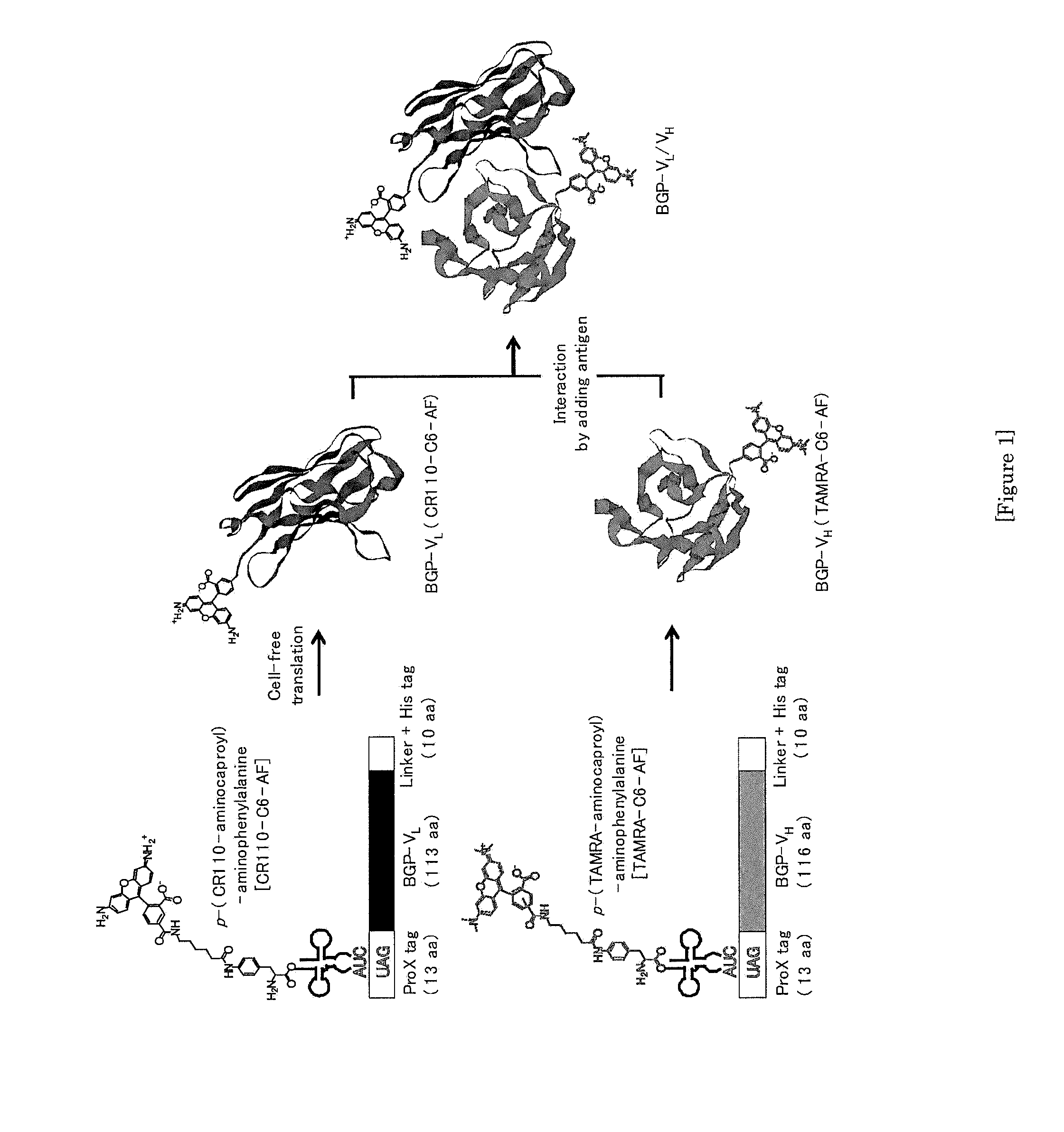Fluoroimmunoassay Method
a fluoroimmunoassay and measurement method technology, applied in the direction of fluorescence/phosphorescence, instruments, peptides, etc., can solve the problems of time consumption and complicated steps, and achieve the effect of low cost, high accuracy of measurement results, and quick and simple quantitative measuremen
- Summary
- Abstract
- Description
- Claims
- Application Information
AI Technical Summary
Benefits of technology
Problems solved by technology
Method used
Image
Examples
example 1
1. Establishment of Homogenous Fluorescence Based Immunoassay Using VH and VL Derived from Anti-BGP Antibody
(Construction of Anti-BGP Antibody V-Region Gene Expression Vector)
[0114]To a DNA sequence encoding a heavy-chain variable region (VH: SEQ ID No:1) or a light-chain variable region (VL: SEQ ID No:2) of an antibody against human osteocalcin (human Bone Gla Protein: BGP), a DNA sequence of ProX™tag (MSKQIEVNXSNET (X represents a fluorescent-labeled amino acid); SEQ ID No:3) containing an amber codon at the N-terminal was added. The resultant gene was inserted between the NcoI / HindIII sites of pIVEX2.3d vector (manufactured by Roche Diagnostics). The expression vector constructed is designed such that ProX™tag (MSKQIEVNXSNET (X represents a fluorescent-labeled amino acid): SEQ ID No:3) is added to the N-terminal of the inserted VH or VL, while His-tag is added to the C-terminal. FIG. 1 schematically shows that a CR110-labeled anti-BGP antibody light-chain variable region polypept...
example 2
Measurement of Fluorescence Spectra
[0118]A sample was prepared by adding the TAMRA-labeled anti-BGP antibody VH protein and CR110-labeled anti-BGP antibody VL protein (1 μg / mL, 30 μL for each protein) prepared in Example 1 and 7-residue BGP C-terminal peptide (RRFYGPV; SEQ ID No:8) serving as an antigen and adjusted so as to have a total volume of 200 μL with PBS (+0.05% Tween20). After the mixture was allowed to stand still at 25° C. for 90 minutes, fluorescence spectra were measured by a fluorescence spectrophotometer (FluoroMax-4; manufactured by HORIBA Jobin Yvon GmbH). The excitation wavelength to the mixture of CR110-VL and TAMRA-VH was set to 490 nm, and the excitation wavelength to TAMRA-VH was set to 550 nm. With respect to the mixture of CR110-VL and TAMRA-VH, a fluorescence intensity ratio, IA / ID, was calculated, in which IA and ID were defined as the fluorescence intensity at 575 nm and 525 nm, respectively. The dissociation constant (Kd) value was calculated based on th...
example 3
Evaluation of Binding Activity of TAMRA-VH and CR110-VL to BGP Peptide
[0120]First, an attempt to establish an antibody / antigen binding activity evaluation system using a fluorescent resonance energy transfer method (FRET) was made. In the FRET measurement, CR110 and TAMRA were used as a donor and an acceptor, respectively. Since fluorescence of the donor (CR110) is sufficiently overlapping with absorption spectrum of the acceptor (TAMRA), they can be used as an FRET pair. Provided that an orientation factor (κ2) is set to be ⅔, the Foerster distance (R0) is calculated as 62 Å, which value is suitable for detecting the intermolecular interaction of proteins. When an antigen is not present, the interaction between VL and VH is poor and thus FRET from CR110 to TAMRA does not occur; whereas, when an antigen is present, VH and VL form a ternary complex with an antigen. As a result, it is predicted to induce FRET from CR110 to TAMRA.
[0121]For the purpose of determining whether FRET from C...
PUM
| Property | Measurement | Unit |
|---|---|---|
| temperature | aaaaa | aaaaa |
| temperature | aaaaa | aaaaa |
| total volume | aaaaa | aaaaa |
Abstract
Description
Claims
Application Information
 Login to View More
Login to View More - R&D
- Intellectual Property
- Life Sciences
- Materials
- Tech Scout
- Unparalleled Data Quality
- Higher Quality Content
- 60% Fewer Hallucinations
Browse by: Latest US Patents, China's latest patents, Technical Efficacy Thesaurus, Application Domain, Technology Topic, Popular Technical Reports.
© 2025 PatSnap. All rights reserved.Legal|Privacy policy|Modern Slavery Act Transparency Statement|Sitemap|About US| Contact US: help@patsnap.com



